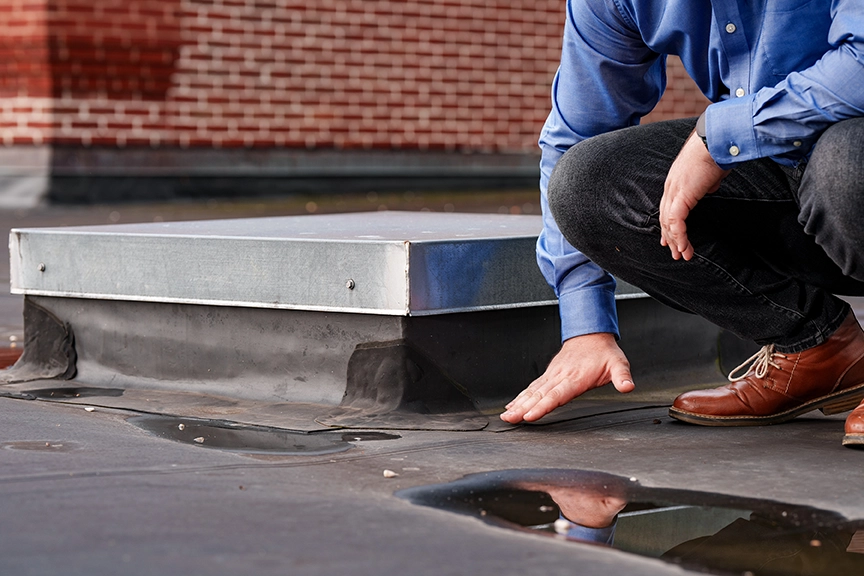How to Create an Action Plan to Protect Your Roof from a Hailstorm
According to the National Oceanographic and Atmospheric Administration (NOAA) for the 12 months from April 2023 to April 2024, there were more than 350 hail storms in Capital Roof Care’s service area of PA, DE, MD, and NJ. The average size of the hail stones was more than 1”, with one report of 3” stones and two with 2.5” stones. Everyone should be prepared for this type of weather event because hail can cause considerable damage! The best way to prepare for a hailstorm is to have an action plan that includes preparation for, what to do during the storm, and how to respond after the storm to protect your commercial roof.

Hailstorm Preparation
Before a hailstorm hits, you should know as much as you can about your roofing system including areas that could become potential threats to your facility’s infrastructure. You should conduct routine roofing inspections and maintenance, keep your assets in good condition, and detect minor issues early on so they don’t become an emergency roofing repair. In addition, identify and repair vulnerabilities like loose shingles, weak spots, or leaks and also review your company’s insurance policy to ensure it covers hail damage.
Since hail is linked to thunderstorms, these storms occur most often during the summer or in parts of the United States with a more tropical climate. You should continue to stay informed about weather conditions through local news, weather apps, or NOAA Weather Radio.
Also it’s important to be proactive and take steps to prepare your commercial roof from potential hail damage. This can be achieved by using only impact-resistant roofing materials such as Class 4 shingles, metal roofing, or synthetic roofing tiles. A protective roofing membrane or coating can be helpful as it absorbs hail impact and reduces damage. Installing hail guards will protect items on top of your roof such as HVAC units, skylights, and other rooftop equipment. These guards are specially designed to withstand hail impact.
An additional measure of protection is inspecting trees and shrubbery around your building; trim overhanging branches and remove loose objects from the roof to prevent them from becoming projectiles during the storm.
Before and During the Storm
Once the storm hits, there are several things you can do to ensure your building and employees are safe. First, make sure all doors and windows are closed and secured and if possible, move valuable equipment away from areas vulnerable to leaks. Second, restrict access to the roof during the storm and instruct your employees to stay indoors and away from windows, skylights, and doors. Finally, you should continue to listen for weather updates and potential emergency instructions.
After the Storm
After the storm is over, inspect your roof for damage by checking for dents, cracks, tears, punctures, and displaced aggregate. Document all damage with photographs and clear, detailed notes. Also be aware that due to its design, buildings with a flat roof sometimes have an increase of water pooling and seeping through openings. Finally, contact your insurance company to report damage and begin the claims process.
Once all damage has been completely documented, you should begin the cleanup process. If necessary, make temporary repairs to prevent further damage and document these repairs/costs, then begin clearing away debris. If permanent repairs are required, be sure to hire a professional roofing contractor because if not addressed promptly, small roof problems can develop into larger, more costly issues that can result in a roofing emergency. You should keep your detailed receipts to submit for insurance claims.
Depending on where you live and the amount of damage your roof sustains, it may be time to consider a roof replacement vs. repair. If you decide on a new roof, select a material that is resistant to hail damage. Commercial roofing materials like metal and single-ply roof membranes including EPDM, TPO, and PVC and also built-up tar and gravel roofs are recommended.
By creating an action plan and knowing what to do before, during, and after a hailstorm, your facility will be better prepared to respond to and recover from a severe weather event, which will ensure the safety and well-being of your employees and facility. For more information on roofing options that are resistant to hail or about setting up a commercial roof maintenance plan, contact Capital Roof Care.
Sources:
https://hazards.fema.gov/nri/hail